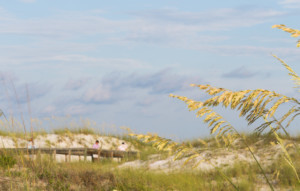 In September 2004, Hurricane Ivan pummeled our shoreline with 100-plus surface winds as a category three hurricane. In addition to strong winds, Ivan brought an eight-foot-plus storm surge. The wind and water erased the numerous dunes of our coastline and it has taken years for them to build back.
In September 2004, Hurricane Ivan pummeled our shoreline with 100-plus surface winds as a category three hurricane. In addition to strong winds, Ivan brought an eight-foot-plus storm surge. The wind and water erased the numerous dunes of our coastline and it has taken years for them to build back.
Each year as June 1 rolls around, our thoughts are on hurricane season and what needs to be done to protect our livelihoods. One of the ways we protect our homes and businesses that dot the coastline is a wall built by nature: the beautiful white–sand dunes. A natural barrier, sand dunes are our first line of defense against the destructive wind and waves of a storm.
In spite of having such a hard job, the dunes are actually very fragile. The seagrasses, sea oats and scrub that grow on the dunes help hold them together. Without that root system, the sand would just blow away.
That’s why we need to take precautions and practice the Leave Only Footprints lifestyle as we enjoy our day at the beach. Just follow a few simple steps to help protect the dunes:
- Avoid walking on any beach vegetation. Plant roots hold our dunes together.
- Use boardwalks or marked paths when entering or exiting the beach.
- Although the dunes are beautiful as a background in photos, climbing on them or even getting too close is harmful. Please keep your distance. If you feel a root break under your foot, you’ve already gone too far.
- Don’t litter. Pack all of your trash during your visit and take it with you when you leave.
- Be respectful of wildlife. The dunes are a habitat for birds, the endangered beach mouse and numerous other coastal creatures.
Remembering to treat our beaches with care will ensure they remain healthy and available for future visits and future generations.

